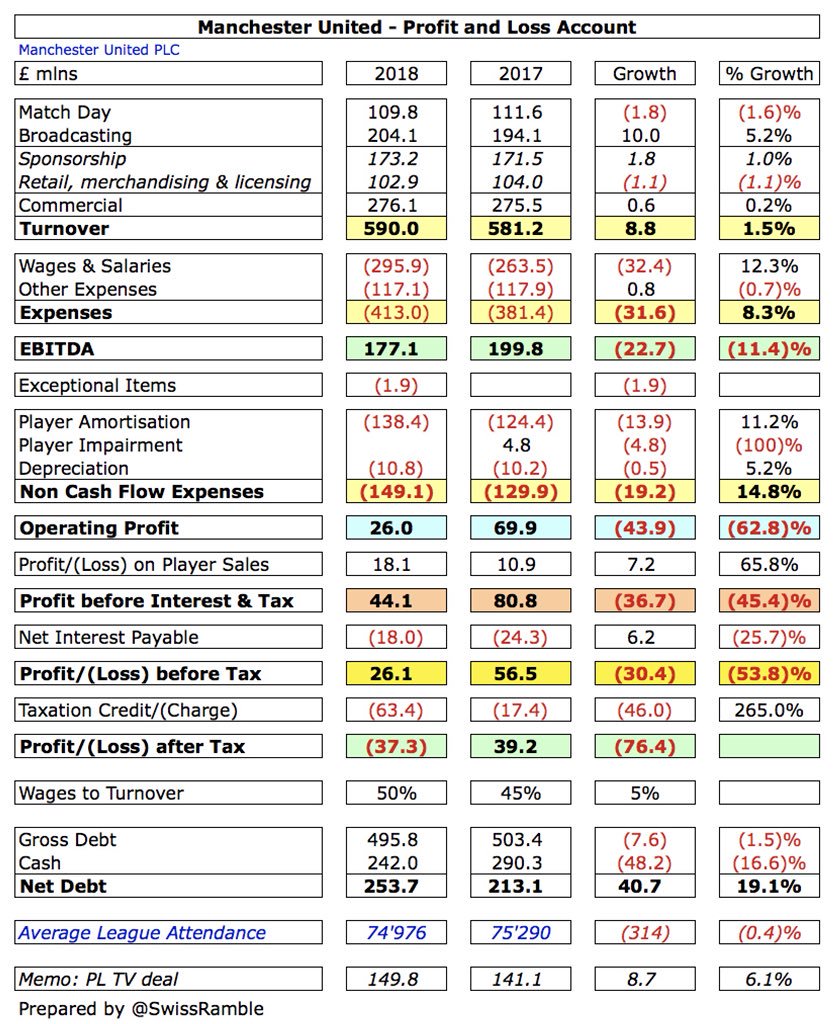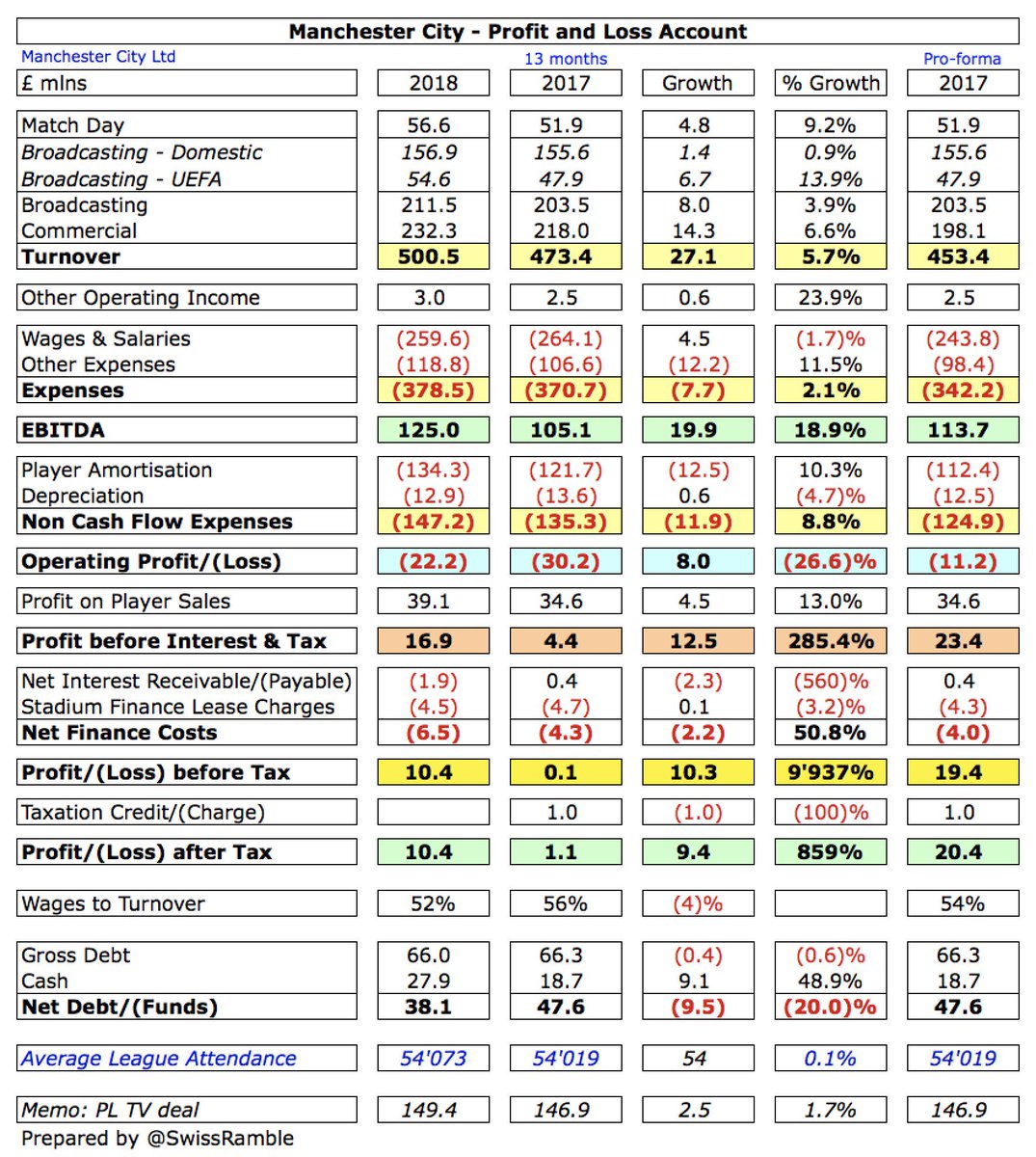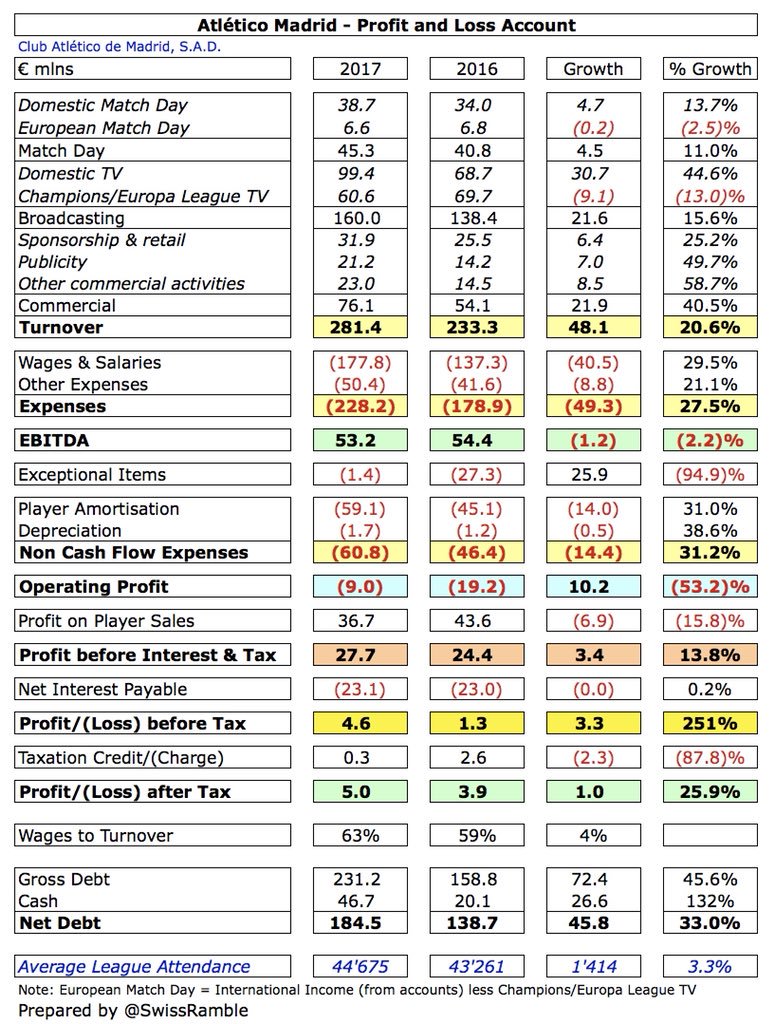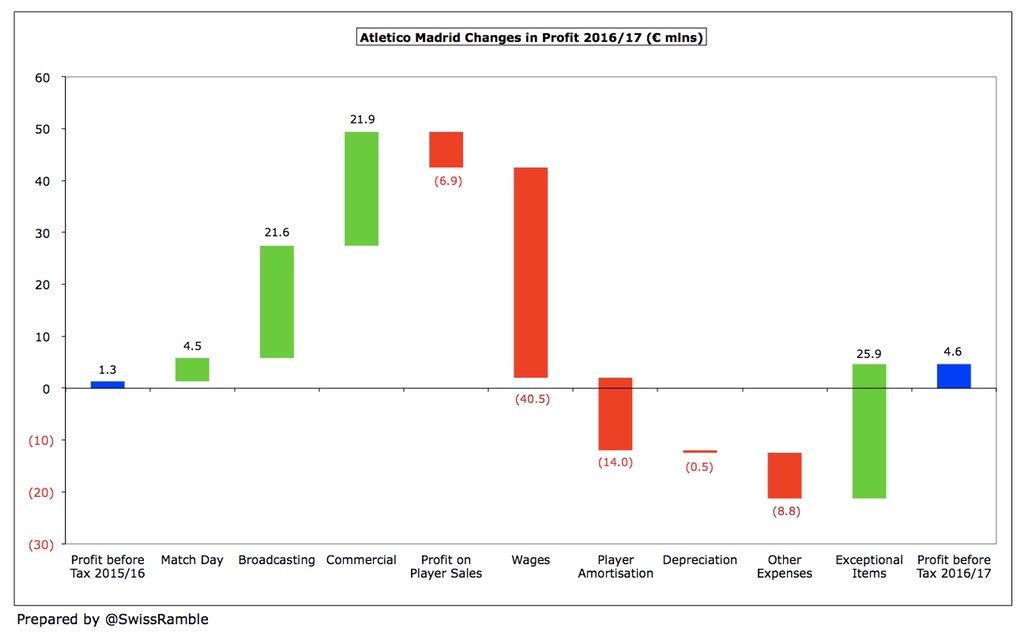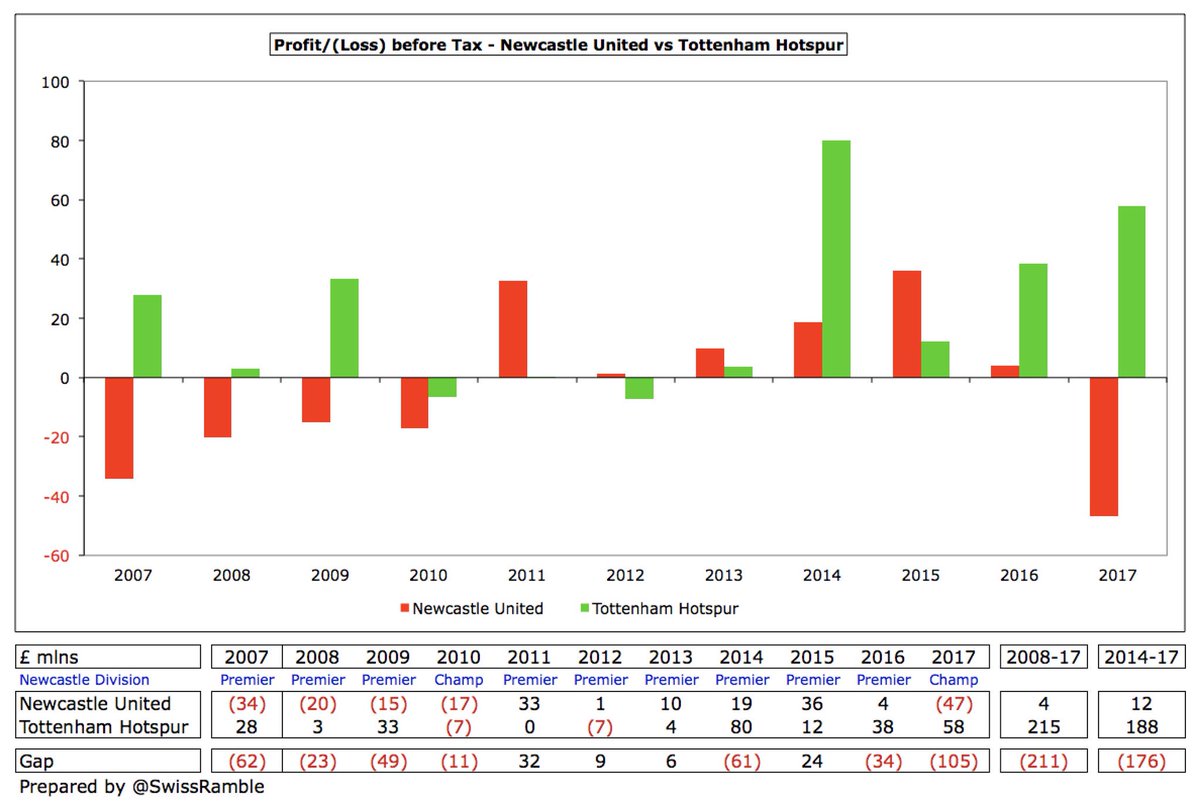Liverpool’s 2016/17 financial results included their highest ever revenue, despite not playing in Europe, though they finished 4th in the Premier League and reached the semi-finals of the EFL Cup. Some thoughts in the following thread #LFC
#LFC converted £20m loss before tax to £40m profit with revenue growing by 21% (£62m) to a record £364m, though profit on player sales was down £4m at £38m (mainly Christian Benteke, Jordon Ibe, Joe Allen & Martin Skrtel), as no repeat of Raheem Sterling’s big money sale to City. 

#LFC revenue was driven by the new Premier League TV deal, though partly offset by no Europa League money, with a net increase in broadcasting income of £31m to £154m. The expanded Main Stand saw match day rise £11m to £74m, while commercial was up £21m to £136m. 

#LFC managed to trim the wage bill by £1m, though it seems likely that prior year included £16m pay-offs to Brendan Rodgers and other staff, so underlying growth is £15m (8%). Also reduced player amortisation and impairment by £14m.
On the other hand, #LFC saw some cost growth: other expenses were £9m higher; depreciation increased by £3m following the stadium investment; while interest payable was up £1.5m to £5.4m.
#LFC £40m profit is very impressive (11th best ever in the Premier League), but for some perspective all clubs that have published 2016/17 accounts to date are profitable. In fact, Liverpool’s profit has been bettered by 4 clubs: #LCFC £92m, #MUFC £57m, #AFC £45m & #WHUFC £43m. 

#LFC have made a profit 3 times in last 4 seasons (£1m in 2014, £60m in 2015). This followed 5 years of losses, amounting to £176m. As the club stated, #LFC “has been transformed to a financially stable, sustainable and growing football club since FSG took ownership in 2010.” 

#LFC figures have frequently suffered from so-called exceptional items, which have increased costs by £113m in the decade up to 2016, mainly (unsuccessful) stadium development expenses £61m and compensation for sacked managers £47m, though nothing in 2017. 

Profit from player sales has a major impact on #LFC figures. Last 3 years averaged £46m, compared to just £11m in previous 7 years, including 3 years of losses 2012-14 (mainly Andy Carroll). Next year will benefit from huge sale of Coutinho to Barcelona + Sakho to Palace. 
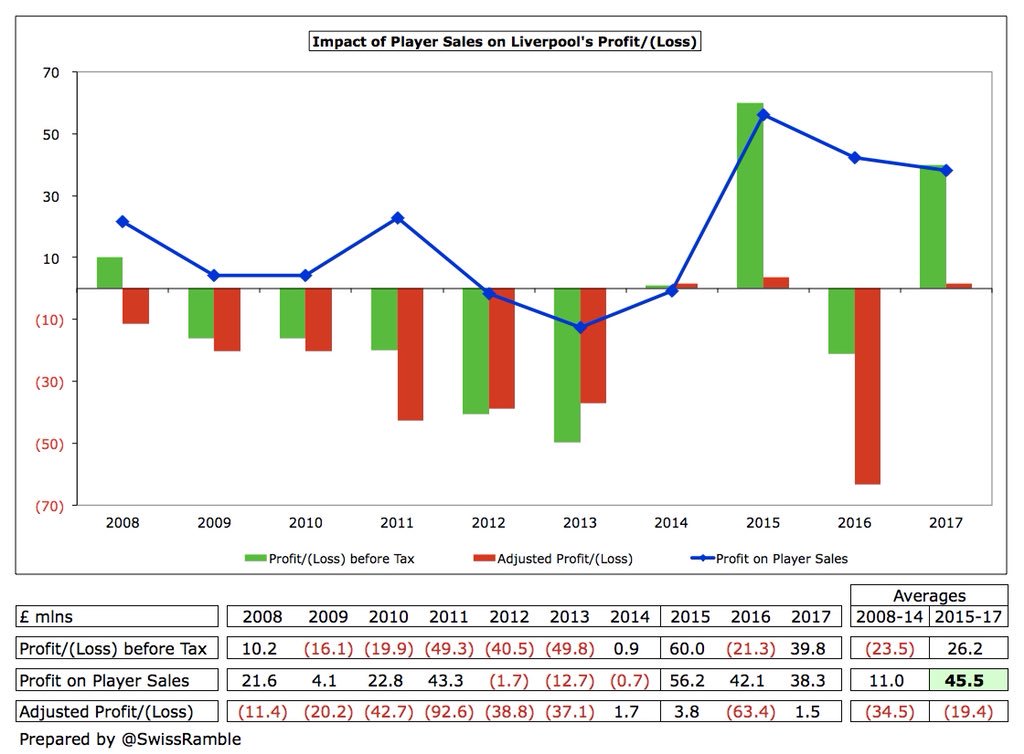
That said, #LFC EBITDA (Earnings Before Interest, Tax, Depreciation & Amortisation), which can be considered as a proxy for cash operating profit, surged from £20m to £74m in 2017. 
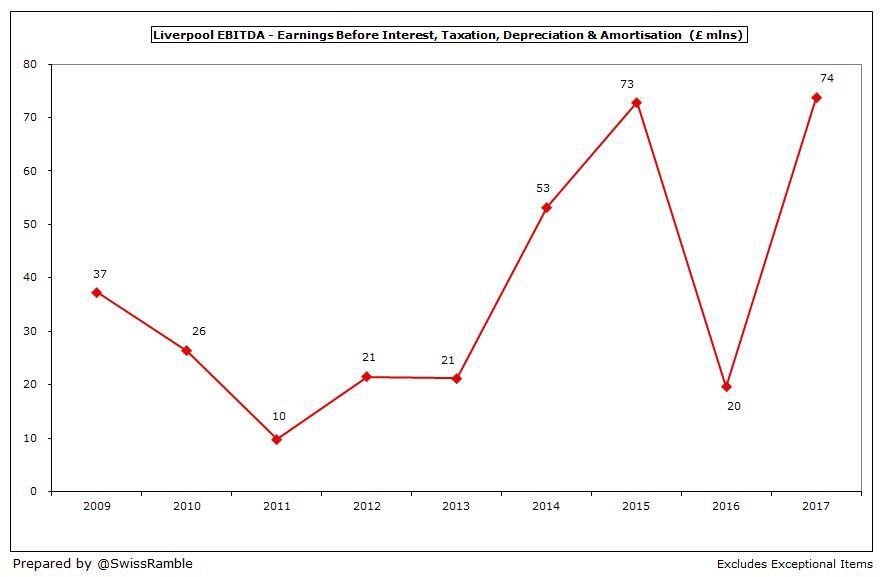
Despite this substantial growth, #LFC EBITDA of £74m is still only around a third of #MUFC’s £200m, which is due to United’s amazing ability to generate cash. It is also behind #AFC £138m, #MCFC £105m and more surprisingly #LCFC £88m (due to their Champions League exploits). 

Revenue has increased at #LFC six years in a row, virtually doubling from £184m in 2011 to £364m in 2017. Most of this (£89m) has been driven by TV money, but there has also been impressive growth in the other revenue streams: commercial £59m and match day £33m. 
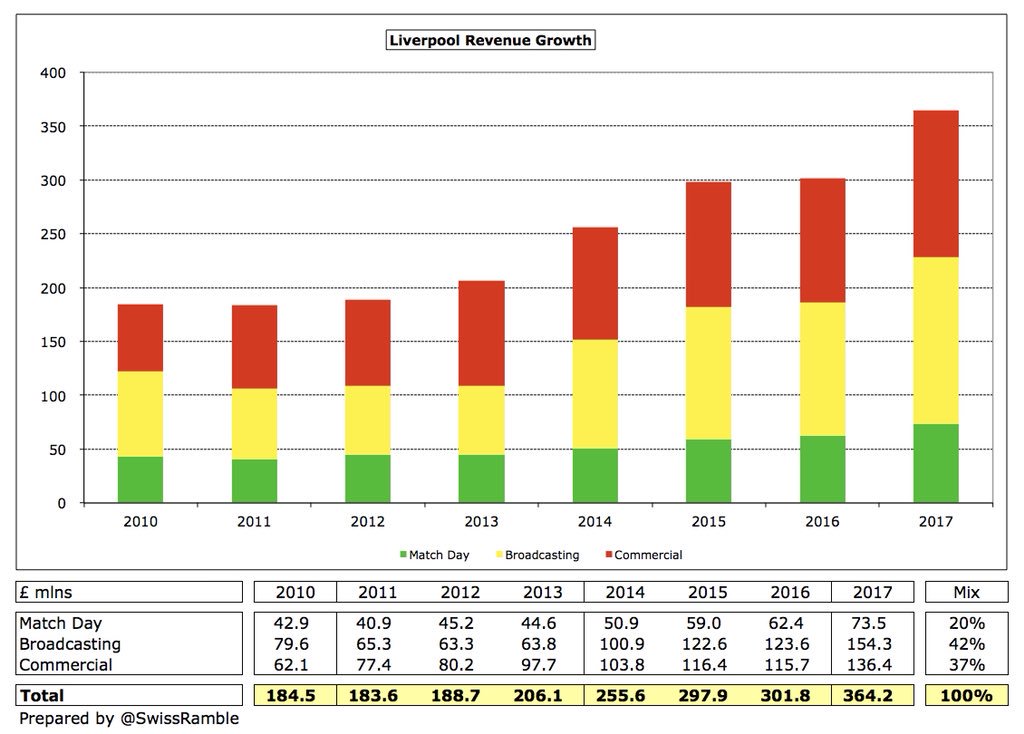
The lack of Champions League money means that #LFC £364m revenue is a fair way behind their rivals, e.g. #MUFC £581m (over £200m higher,) #MCFC £473m and #AFC £423m. However, it will be much closer in 2017/18 now that the Reds are back in Europe’s elite competition. 

Although #LFC’s £63m revenue growth last season was pretty striking, it was actually less than all the other leading clubs with the exception of Chelsea (#THFC £96m, #MCFC £82m, #AFC £72m and #MUFC £66m), again due to not participating in the Champions League. 

More positively, #LFC had the 9th highest revenue in the world in 2016/17 per the Deloitte Money League, just ahead of Juventus. This was largely due to the impact of the new Premier League TV deal. 
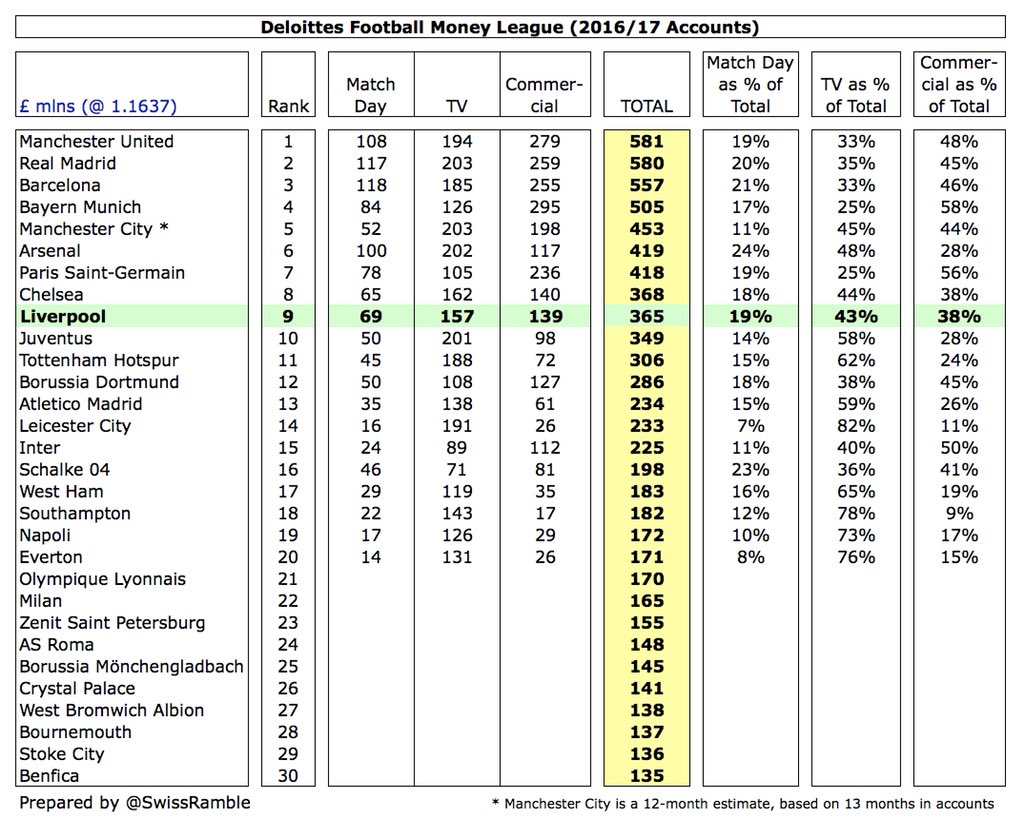
#LFC TV money from the Premier League increased £56m to £146m, due to the new three-year deal, which was boosted by finishing 4th versus 8th the previous season (merit payment) and being shown live 29 times against 25 in 2015/16 (facility fee). 
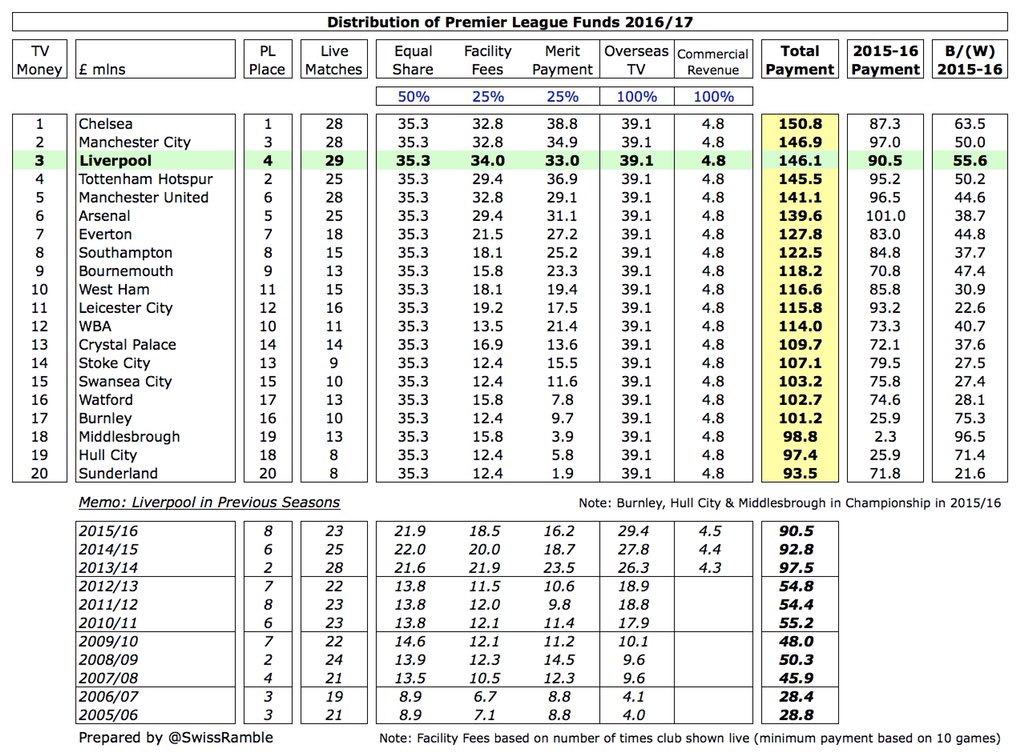
The failure to qualify for Europe adversely impacted #LFC figures, as they earned €38m TV money for reaching the final of the Europa League in 2015/16. Although this is very much Europe’s secondary competition, clubs can still earn well if they go a long way. 
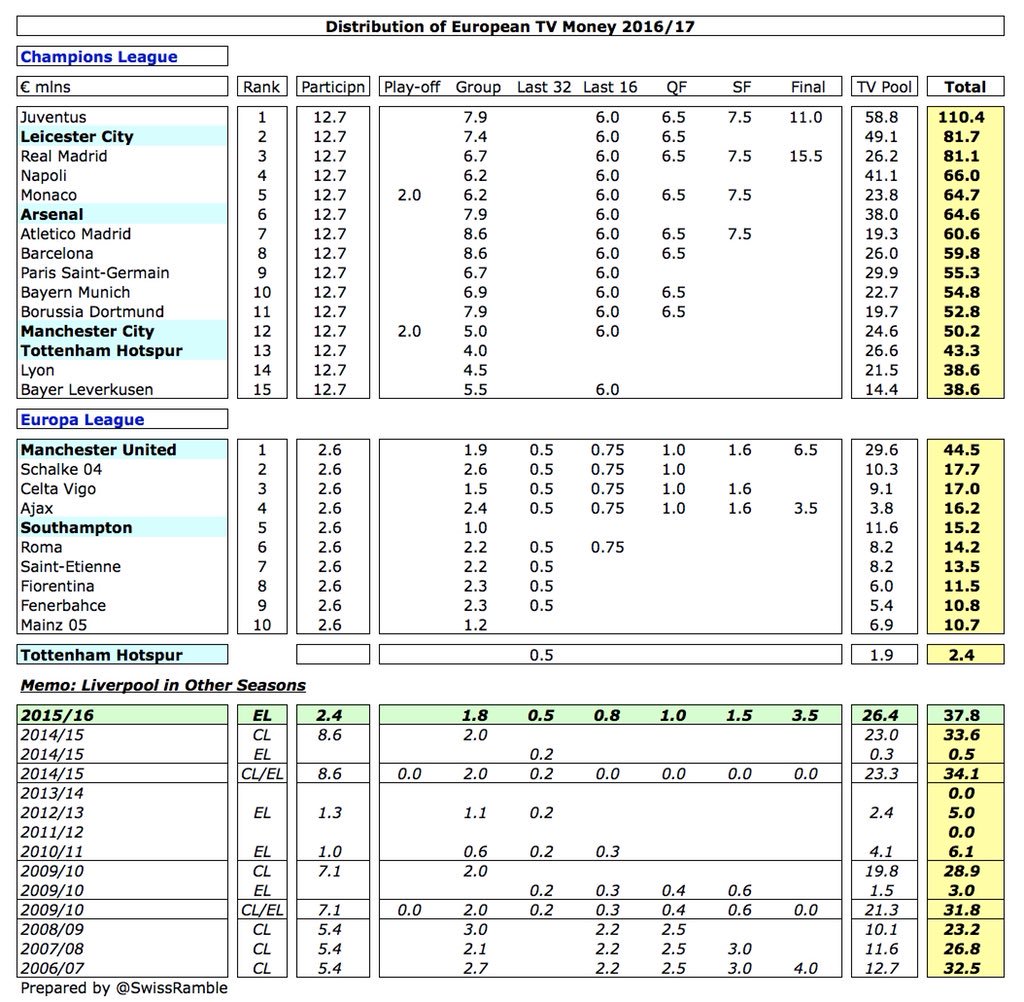
Despite the enormous increases in Premier League distributions, European participation can still make a difference for the leading clubs. #LFC have earned €77m from Europe in the last five years, but this is much less than #MCFC €244m, #AFC €213m, #CFC €193m and #MUFC €167m. 

That’s why #LFC return to the Champions League is so important to their aspirations. To date, they have earned €56m in 2017/18 for reaching the quarter-finals after eliminating Porto last week. This could rise if they make further progress. 
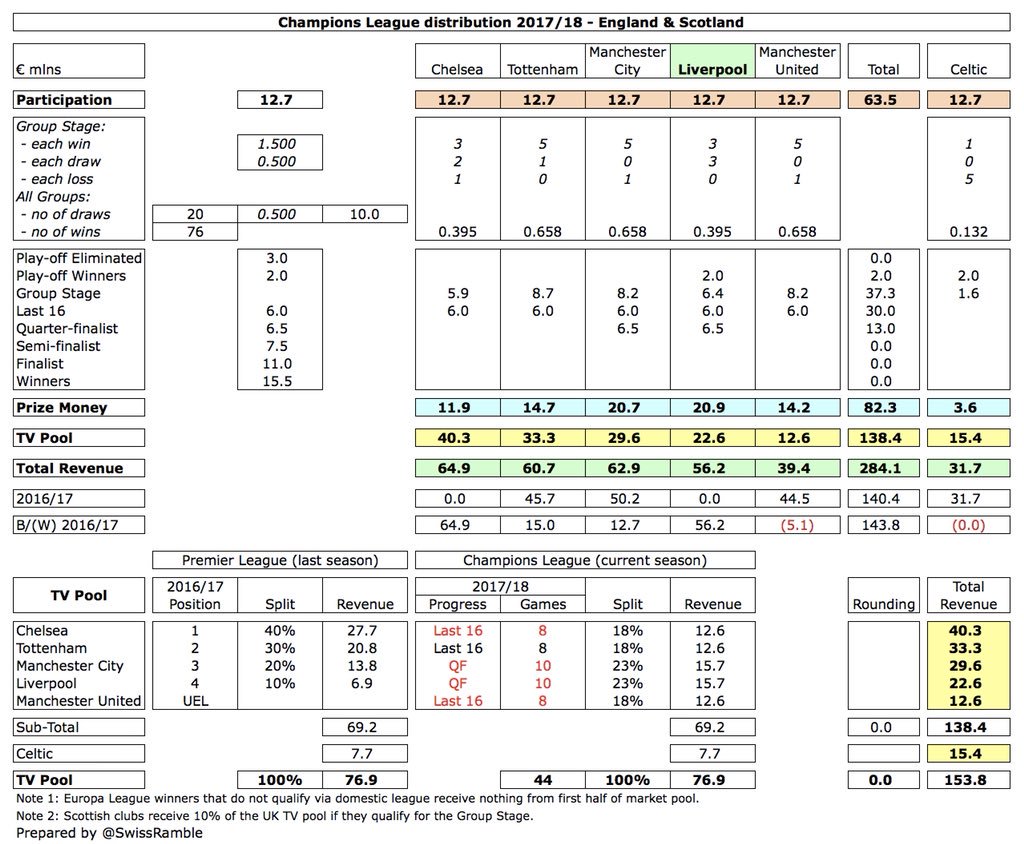
The expanded main stand at Anfield led to match day income increasing £12m (18%) from £62m to £74m, mainly due to hospitality sales. This is the 3rd highest in the PL, only behind #MUFC and #AFC, and compares to £43m when FSG bought the club in 2010. 

Revenue increase would have been even higher if #LFC had been in Europe (7 fewer games in 2016/17), so 2017/18 will be a better comparative. #LFC average attendance of 53,016 was the 5th highest in the Premier League. Ticket prices have been frozen since 2015/16. 

#LFC commercial revenue was up 18% (£20m) from £116m to £136m (the third highest in England), mainly due to the new £8m training kit deal with BetVictor and 12 new partnerships, including Malaysia Airlines, Konami and Joie. 
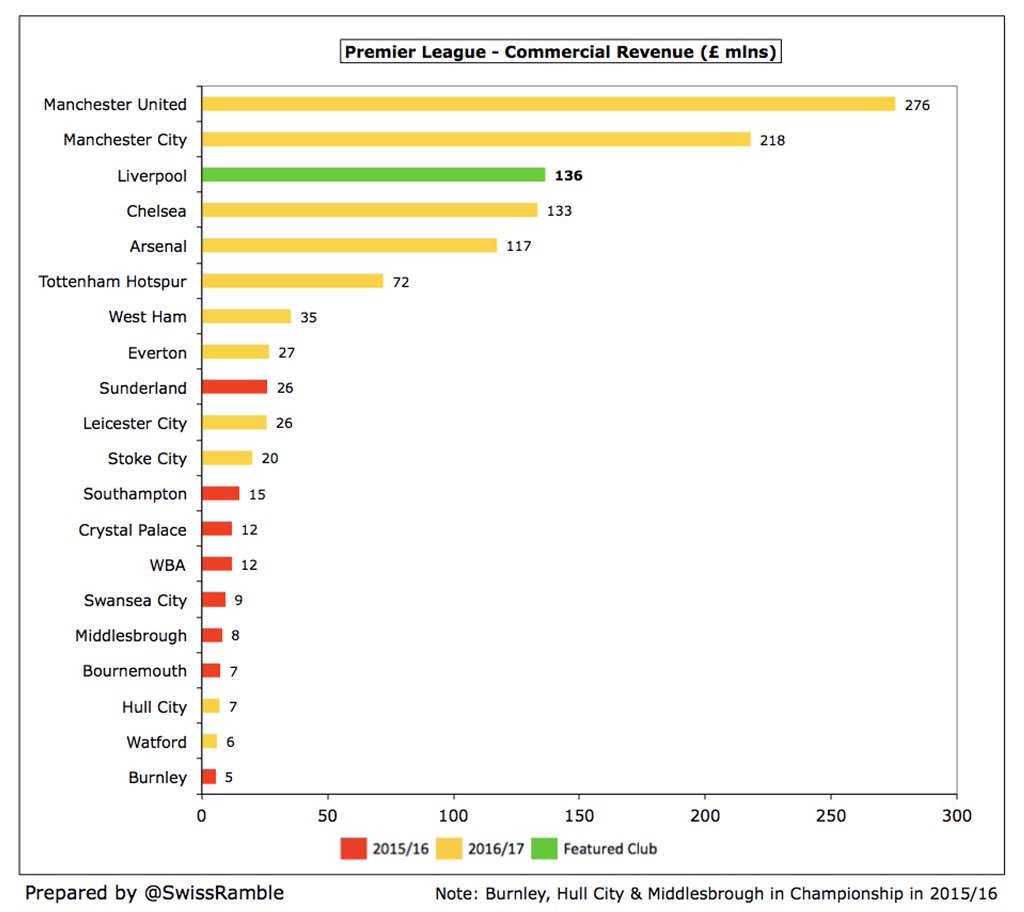
Next year #LFC commercials will be boosted by £5m sleeve sponsor deal with Western Union. The Standard Chartered £30m shirt sponsorship (extended to 2018/19) was pretty good, but has fallen behind #MUFC Chevrolet £54m, #CFC Yokohoma £40m, #AFC Emirates £40m & #MCFC Etihad £35m. 

The reported #LFC wage bill was basically flat at £208m, though it now seems likely that last year’s figure included £16m pay-offs for Brendan Rodgers and his staff, so the underlying increase was 8%. Wages to turnover ratio reduced from 69% to 57% following high revenue growth. 
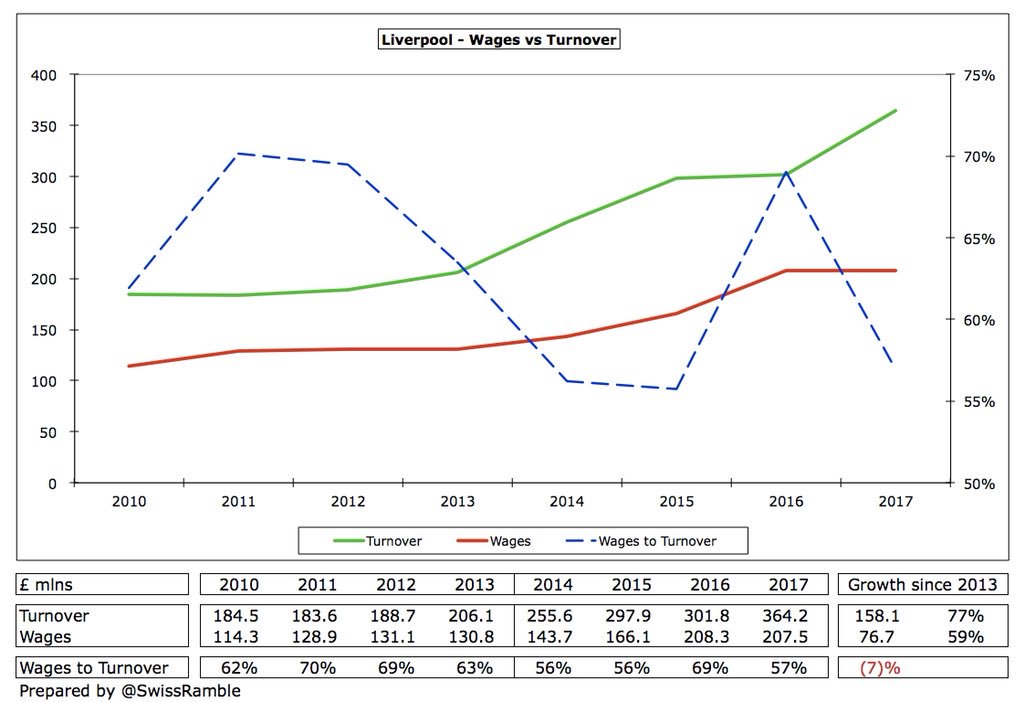
No increase in #LFC £208m wage bill has widened gap to the Manchester clubs with both rising to £264m in 16/17 (though City’s figures cover 13 months, due to change in accounting close, so £244m is a better comparative), while #CFC are also higher £220m. 

Nevertheless, #LFC wages are still higher than all other Premier League clubs, notably #AFC £199m, #LCFC £113m, #EFC £105m and #THFC £100m (2015/16 figures). Furthermore, Liverpool’s wages will surely rise in 2017/18 (new players, Champions League bonuses). 

As a result of higher PL TV money, all clubs have reduced their wages to turnover ratio tin 2016/17. Even after #LFC improvement to 57%, they are still higher than most major clubs that have already reported (#MUFC 45%, #AFC 47% and #MCFC 56%), though better than #CFC 61%. 

After several years of rising #LFC player amortisation, this fell £6m (10%) from £64m to £58m, while there was no repeat of the previous year’s £8m player impairment. 
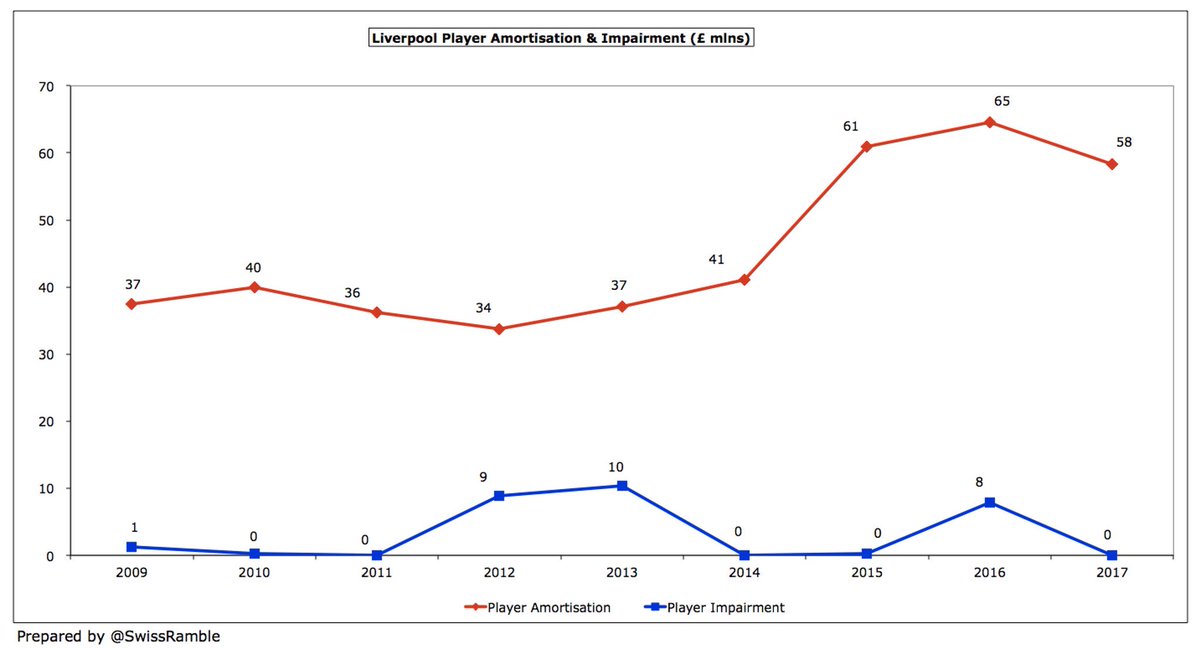
Despite the decrease, #LFC player amortisation of £58m is still the 5th highest in England. That said, it is less than half of big-spending #MUFC £124m and #MCFC £122m, though it will again rise in 2017/18 after the purchases in the last two transfer windows. 

Other expenses also rose 12% (£9m) from £74m to £83m in 2016/17 without any real explanation. This cost category has increased 80% since 2012. 
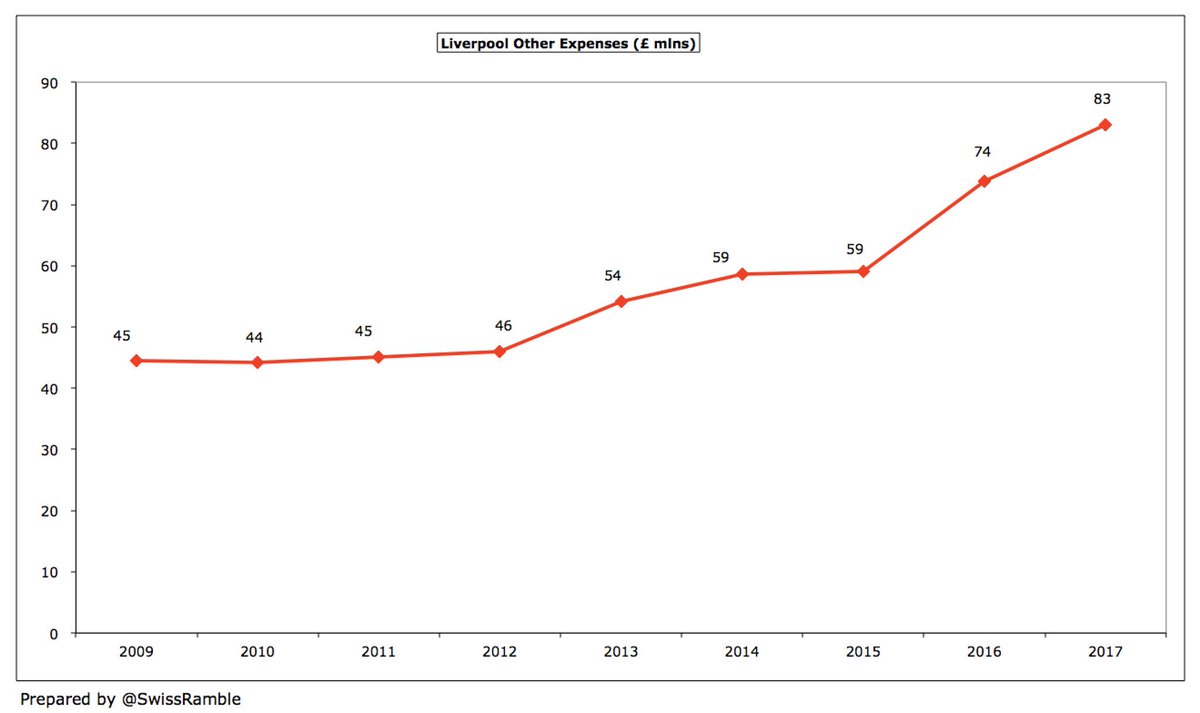
#LFC made player purchases of £76m in 2016/17 (including Mane, Wijnaldum, Karius, Klavan & Matip), which might sound impressive, but is actually less than #LCFC £102m, #EFC £92m, #WHUFC £81m, as well as the usual suspects with #MUFC and #MCFC both splashing out more than £200m. 

On a cash basis, #LFC net spend has increased in the last 3 seasons to an annual average of £45m, around 50% more than the £31m for 2009-14. Since these accounts closed, #LFC have bought van Dijk, Salah and The Ox, but have recouped most of the cost by selling Coutinho and Sakho. 

#LFC gross debt rose £18m to £182m. All of the increase was in bank debt, up to £72m (interest 1.48%), while the loan provided by the owners to fund the stadium expansion was unchanged at £110m (interest 1.24%). Level described by club as “sustainable, given financial growth”. 

Nevertheless, #LFC £182m is 3rd highest debt in the Premier League, only behind #MUFC £503m even after all the Glazers’ re-financings and #AFC £227m for the mortgage on the Emirates stadium. However, #LFC annual interest payment of £2.5m is much lower than #MUFC £20m & #AFC £13m. 

#LFC generated an impressive £74m cash from operations in 2016/17, though still required an additional £18m bank loan, as they spent £39m on player purchases (net) and £52m on infrastructure (mainly stadium). Will need to find £50m for new training ground. 
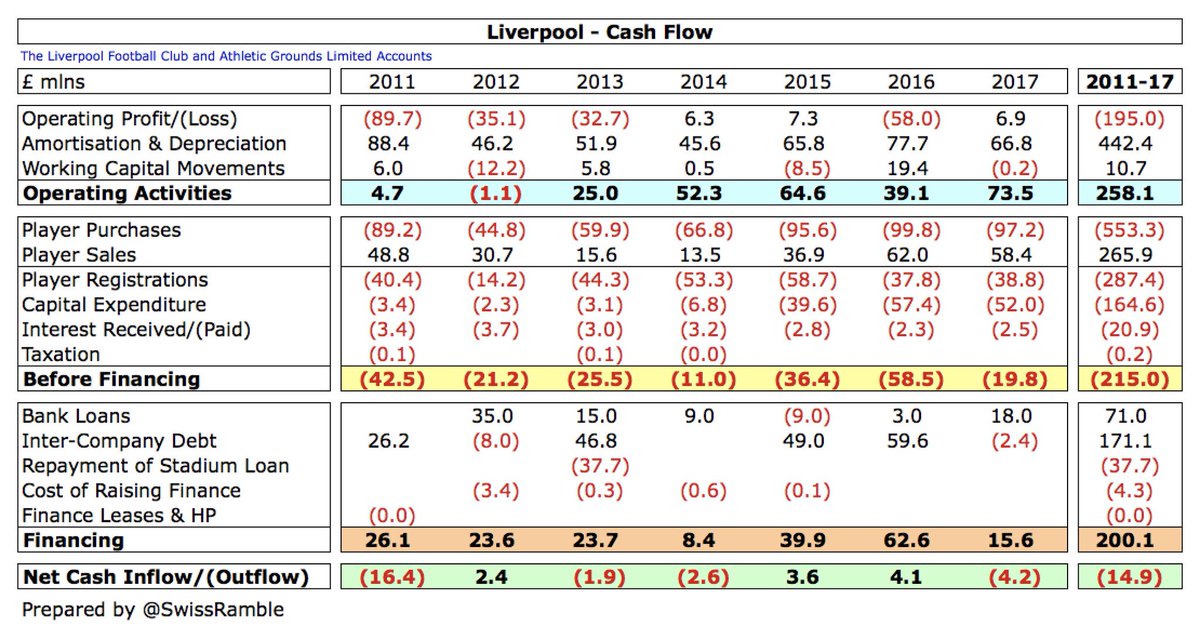
Since FSG acquired the club, the club has had over half a billion of available cash: £258m from operations, £171m from owner loans and £67m from bank loans. £287m went on players (net), £165m capital expenditure, £38m stadium loan repayment and £21m interest payments. 
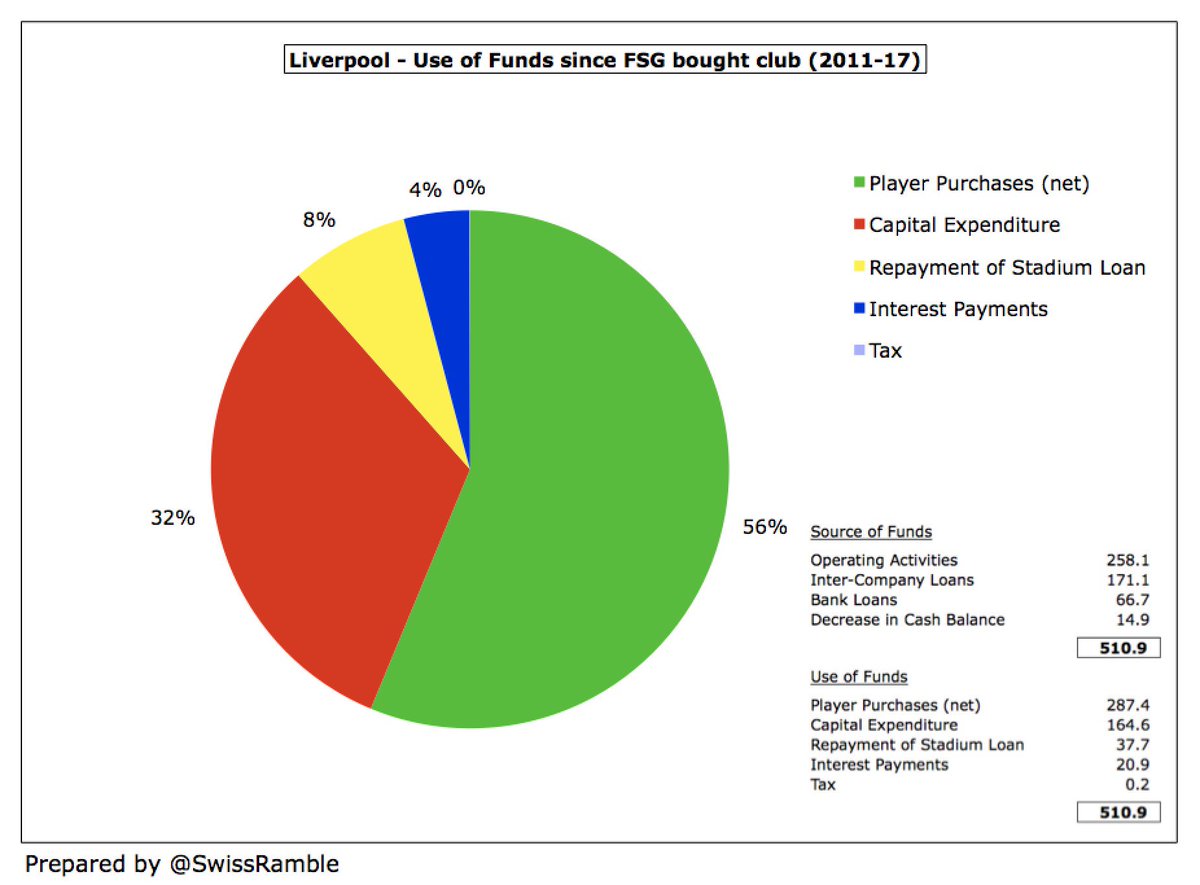
There is little doubt that the #LFC financial position has significantly improved over the past few years. Next year’s revenue will again increase from participation in the Champions League, which should facilitate further improvement on the pitch.
• • •
Missing some Tweet in this thread? You can try to
force a refresh




